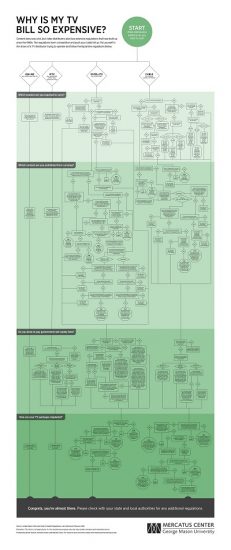After coming across some reviews of Thomas Philippon’s book, The Great Reversal: How America Gave Up on Free Markets, I decided to get my hands on a copy. Most of the reviews and coverage mention the increasing monopoly power of US telecom companies and rising prices relative to European companies. In fact, Philippon tells readers in the intro of the book that the question that spurred him to write Great Reversal is “Why on earth are US cell phone plans so expensive?”
As someone who follows the US mobile market closely, I was a little disappointed that the analysis of the telecom sectors is rather slim. There’s only a handful of pages (out of 340) of Europe-US telecom comparison, featuring one story about French intervention and one chart. This isn’t a criticism of the book–Philippon doesn’t pitch it as a telecom policy book. However, the telecom section in the book isn’t the clear policy success story it’s described as.
The general narrative in the book is that US lawmakers are entranced by the laissez-faire Chicago school of antitrust and placated by dark money campaigns. The result, as Philippon puts it, is that “Creeping monopoly power has slowly but surely suffocated the [US] middle class” and today Europe has freer markets than the US. That may be, but the telecom sectors don’t provide much support for that idea.
Low Prices in European Telecom . . .
Philippon says that “The telecommunications industry provides another example of successful competition policy in Europe.”
He continues:
The case of France provides a striking example of competition. Free Mobile . . . obtained its 4G license [with regulator assistance] in 2011 and became a significant competitor for the three large incumbents. The impact was immediate. . . . In about six months after the entry of Free Mobile, the price paid by French consumers had dropped by about 40 percent. Wireless services in France had been more expensive in the US, but now they are much cheaper.
It’s true, mobile prices are generally lower in Europe. Monthly average revenue per user (ARPU) in the US, for instance, is about double the ARPU in the UK (~$42 v. ~$20 in 2016). And, as Philippon points out, cellular prices are lower in France as well.
One issue with this competition “success story”: the US also has four mobile carriers, and had four mobile carriers even prior to 2011. Since the number of competitors is the same in France and the US, competition doesn’t really explain why there’s a price difference between France and the US. (India, for instance, has fewer providers than the US and France–and much lower cellular prices, so number of competitors isn’t a great predictor of pricing.)
. . . and Low Investment
If “lower telecom prices than the US” is the standard, then yes, European competition policy has succeeded. But if consumers and regulators prioritize other things, like industry investment, network quality (fast speeds), and rural coverage, the story is much more mixed. (Bret Swanson at AEI points to other issues with Philippon’s analysis.) Philippon’s singular focus on telecom prices and number of competitors distracts from these other important competition and policy dimensions.
According to OECD data, for instance, in 2015 the US exceeded the OECD average for spending on IT and communications equipment as a percent of GDP. France might have lower cell phone bills, but US telecom companies spend 275% more than French telecom companies on this measure (1.1% of GDP v. 0.4% of GDP) .
Further, telecom investment per capita in the US was much higher than its European counterparts. US telecom companies spent about 55 percent more per capita than French telecoms spent ($272 v. $175), according to the same OECD reports. And France is one of the better European performers. Many European carriers spend, on a per capita basis, less than half what US carriers spend. US carriers spend 130% more than UK telecoms spend and 145% more than German telecoms.
This investment deficit in Europe has real-world effects on consumers. OpenSignal uses crowdsourced data and software to determine how frequently users phones have a 4G LTE network available (a proxy for coverage and network quality) around the world. The US ranked fourth the world (86%) in 2017, beating out every European country, save Norway. In contrast, France and Germany ranked 60th and 61st, respectively, for this network quality measure, beat out by less wealthy nations like Kazakhstan, Cambodia, and Romania.
The European telecom regulations and anti-merger policies created a fragmented market and financially strapped companies. As a result, investors are fleeing European telecom firms. According to the Financial Times and Bloomberg data, between 2012 and 2018, the value of Europe’s telecom companies fell almost 50%. The value of the US sector rose by 70% and the Asian sector rose by 13% in that time period.
Price Wars or 5G Investment?
Philippon is right that Europe has chosen a different path than the US when it comes to telecom services. Whether they’ve chosen a pro-consumer path depends on where you sit (and live). Understandably, academics and advocates living in places like Boston, New York and DC look fondly at Berlin and Paris broadband prices. Network quality outside of the cities and suburbs rarely enters the picture in these policy discussions, and Philippon’s book is no exception. US lawmakers and telecom companies have prioritized non-price dimensions: network quality, investment in 5G, and rural coverage.
If anything, European regulators seem to be retreating somewhat from the current path of creating competitors and regulating prices. As the Financial Times wrote last year, the trend in Europe telecom is consolidation. The French regulator ARCEP reversed course last year signaled a new openness to telecom consolidation.
Still, there are significant obstacles to consolidation in European markets, and it seems likely they’ll fall further behind the US and China in rural network coverage and 5G investment. European telecom companies are in a bit of panic about this, which they expressed in a letter to the European Commission this month, urging reform.
In short, European telecom competition policy is not the unqualified success depicted in Great Reversal. To his credit, Philippon in the book intro emphasizes humility about prognostications and the limits of experts’ knowledge:
I readily admit I don’t have all the answers. …I would suggest . . . that [economists’] prescriptions be taken with a (large) grain of salt. When you read an author or commentator who tells you something obvious, take your time and do the math. Almost every time, you’ll discover that it wasn’t really obvious at all. I have found that people who tell you that the answers to the big questions in economics are obvious are telling you only half of the story.
Couldn’t have put it better myself.
Credit to Connor Haaland for research assistance.


 One of the keys to improving the standard of living for citizens is to make sure it isn’t too difficult for them to form new businesses or find good jobs. Unfortunately, some governments make that process harder than it should be. San Francisco serves as a prime example. An important new report just out from Arizona State University proves that.
One of the keys to improving the standard of living for citizens is to make sure it isn’t too difficult for them to form new businesses or find good jobs. Unfortunately, some governments make that process harder than it should be. San Francisco serves as a prime example. An important new report just out from Arizona State University proves that.
 The Technology Liberation Front is the tech policy blog dedicated to keeping politicians' hands off the 'net and everything else related to technology.
The Technology Liberation Front is the tech policy blog dedicated to keeping politicians' hands off the 'net and everything else related to technology.